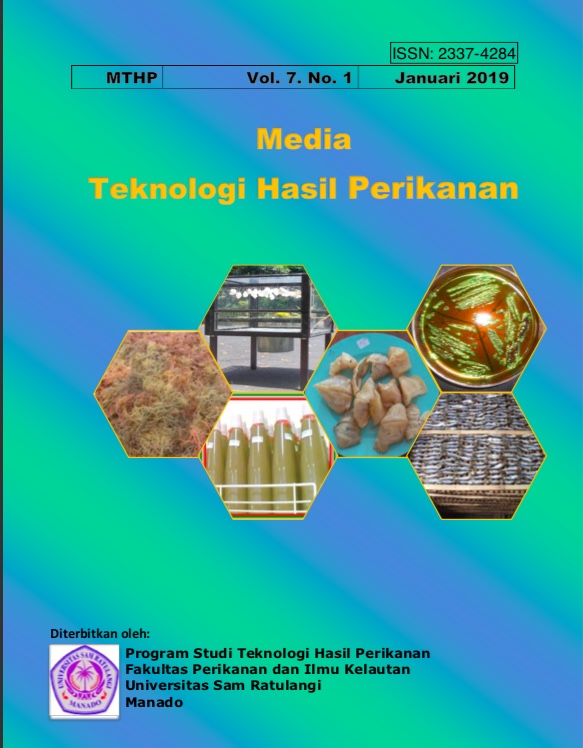PENGOLAHAN IKAN CAKALANG (Katsuwonus pelamis L) ASAP PRESTO
DOI:
https://doi.org/10.35800/mthp.7.1.2019.21364Keywords:
presto smoked skipjack, sensory evaluation, total plate count, ikan cakalang asap, Katsuwonus pelamis L, ikan presto, ALT, suhu ruangan organileptikAbstract
This research objective was to determine the sensory quality and microbial contamination (ALT) of skipjack fish products (Katsuwonus pelamis L) as soon as possible. The treatments tested were 30 and 60 minutes of smoking time, dipresto for 1 hour and then stored at 0, 5 and 10 days at room temperature. The results showed that the ALT value was very precise on the 10th day storage of 6.12 x 105 and the lowest value on day 0 was 4.84 x 102 while the 5th day of the highest highest 2.15 x 104 showed that the product was no longer a recommendation on day 10 because it has exceeded the limit of SNI microbial contamination which is 5.0 x 105. The results of sensory evaluation using hedonic scale 1- 9 indicated that the highest value of color 7.5, smell 7.4, taste 7.9, and texture texture 7.1.
Â
Penelitian ini bertujuan untuk melihat mutu organoleptik dan cemaran mikroba (ALT) pada produk ikan cakalang (Katsuwonus pelamis L) asap presto. Perlakuan yang diujikan adalah lama pengasapan 30 dan 60 menit, dipresto selama 1 jam kemudian disimpan pada 0, 5 dan 10 hari pada suhu ruang. Hasil penelitian menunjukan bahwa nilai ALT tertinggi ada pada penyimpanan hari ke 10 yaitu 6.12 x 105 dan nilai terendah pada hari ke 0 yaitu 4.84 x 102 sedangkan hari ke 5 mendapatkan nilai tertinggi 2.15 x 104 ini menunjukan produk tidak lagi direkomendasikan pada hari ke 10 karena telah melebihi batas cemaran mikroba SNI yaitu 5.0 x 105 . Hasil mutu organoleptik menunjukkan bahwa nilai tertinggi warna 7.5, bau 7.4, rasa 7.9, dan tekstur tekstur 7.1.
Downloads
Published
How to Cite
Issue
Section
License
Authors who publish with this journal agree to the following terms:
- Authors retain copyright and grant the journal right of first publication with the work simultaneously licensed under a Creative Commons Attribution License that allows others to share the work with an acknowledgement of the work's authorship and initial publication in this journal.
- Authors are able to enter into separate, additional contractual arrangements for the non-exclusive distribution of the journal's published version of the work (e.g., post it to an institutional repository or publish it in a book), with an acknowledgement of its initial publication in this journal.
- Authors are permitted and encouraged to post their work online (e.g., in institutional repositories or on their website) prior to and during the submission process, as it can lead to productive exchanges, as well as earlier and greater citation of published work (See The Effect of Open Access).







